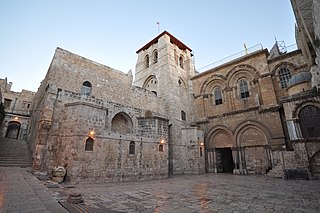 W
WThe Church of the Holy Sepulchre is a church in the Christian Quarter of the Old City of Jerusalem. The church contains, according to traditions dating back to at least the fourth century, the two holiest sites in Christianity: the site where Jesus was crucified, at a place known as Calvary or Golgotha, and Jesus's empty tomb, where he was buried and resurrected. The tomb is enclosed by a 19th-century shrine called the Aedicula. The Status Quo, an understanding between religious communities dating to 1757, applies to the site.
 W
WThe empty tomb is the Christian tradition that on the morning of the first day of the week women followers of Jesus went to the place where he had been buried, where they found the body gone and the tomb occupied by angels. Beyond this the four gospels agree on very little. Mark, the earliest, ends with the women fleeing and telling no one what they have seen ; Matthew introduces guards and a curious doublet whereby the women are told twice, by the angels and then by Jesus, that he will meet the disciples in Galilee; Luke changes Mark's one "young man" to two, adds Peter's inspection of the tomb, and deletes the promise that Jesus would meet his disciples in Galilee; John introduces the "beloved disciple" who visits the tomb with Peter and understands its significance before Peter, and reduces the women to the solitary Mary Magdalene.
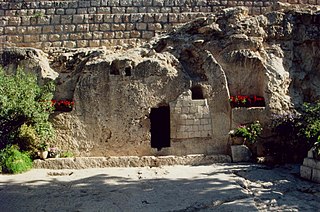 W
WThe Garden Tomb is a rock-cut tomb in Jerusalem, which was unearthed in 1867 and is considered by some Protestants to be the site of the burial and resurrection of Jesus. The tomb has been dated by Israeli archaeologist Gabriel Barkay to the 8th–7th centuries BC. The re-use of old tombs was not an uncommon practice in ancient times, but this would contradict the biblical text that speaks of a new, not reused, tomb made for himself by Joseph of Arimathea. Also, the trough in front of the tomb and the nearby cistern, described by proponents of the Garden Tomb as part of the tomb's sealing system and as the surrounding garden's source of water, respectively, have both been archaeologically dated to the Crusader period. The organisation maintaining the Garden Tomb refrains from claiming that this is the authentic tomb of Jesus, while pointing out the similarities with the site described in the Bible, and the fact that the Garden Tomb better preserves its ancient outlook than the more traditional, but architecturally altered and time-damaged tomb from the mostly crowded Church of the Holy Sepulchre; for all of these reasons, they suggest that the Garden Tomb is more evocative of the events described in the Gospels.
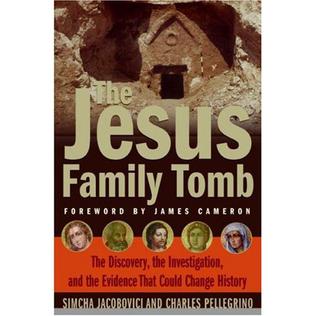 W
WThe Jesus Family Tomb: The Discovery, the Investigation, and the Evidence That Could Change History (ISBN 0061192023) is a controversial book by Simcha Jacobovici and Charles R. Pellegrino published in February 2007. It tells the story of the discovery of the Talpiot Tomb on Friday March 28, 1980 and makes an argument that it is the tomb of Jesus Christ and his "family." However, this claim has been rejected by a majority of leading experts and academics.
 W
WThe Lost Tomb of Jesus is a documentary co-produced and first broadcast on the Discovery Channel and Vision TV in Canada on March 4, 2007, covering the discovery of the Talpiot Tomb. It was directed by Canadian documentary and film maker Simcha Jacobovici and produced by Felix Golubev and Ric Esther Bienstock, while James Cameron served as executive producer. The film was released in conjunction with a book about the same subject, The Jesus Family Tomb, issued in late February 2007 and co-authored by Jacobovici and Charles R. Pellegrino. The documentary and the book's claims have been rejected by many leading experts within the archaeological and theological fields, as well as among linguistic and biblical scholars.
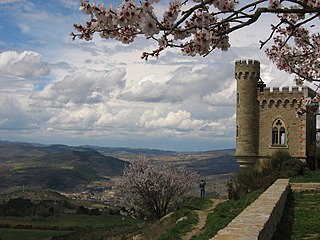 W
WRennes-le-Château is a small commune approximately 5 km south of Couiza, in the Aude department in Languedoc in southern France.
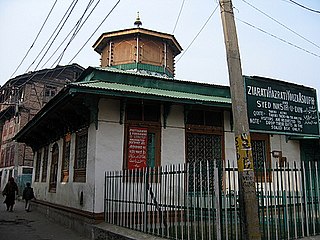 W
WThe Roza Bal or Rouza Bal or Rozabal is a shrine located in the Khanyar quarter in downtown area of Srinagar in Kashmir, India. The word roza means tomb, the word bal mean place. Locals believe a sage is buried here, Yuzasaf or Yuz Asaf, alongside another Muslim holy man, Mir Sayyid Naseeruddin.
 W
WShingō is a village located in Aomori Prefecture, Japan. As of 31 March 2020, the village has an estimated population of 2,408 in 922 households and a population density of 16 persons per km². The total area of the village is 150.77 square kilometres (58.21 sq mi).
 W
WThe Talpiot Tomb is a rock-cut tomb discovered in 1980 in the East Talpiot neighborhood, five kilometers south of the Old City in East Jerusalem. It contained ten ossuaries, six inscribed with epigraphs, including one interpreted as "Yeshua bar Yehosef", though the inscription is partially illegible, and its translation and interpretation is widely disputed. The tomb also yielded various human remains and several carvings.